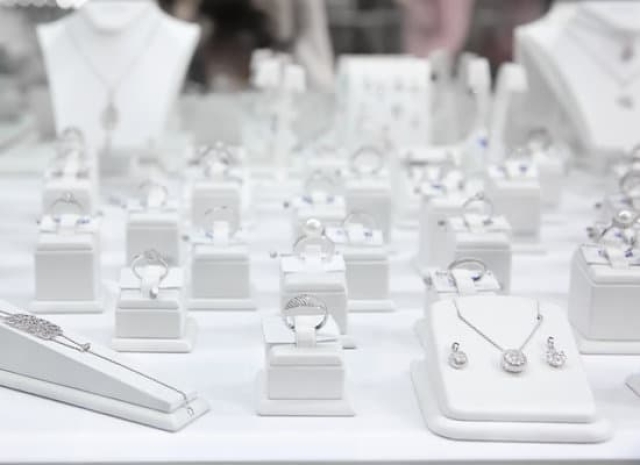Jewelry is a valuable asset, and it’s important to maintain it properly. To do so, it’s important to understand how to care jewelry depending on the material it’s made of. Jewelry can be crafted from a vast array of materials like gold, silver, platinum, gemstones, pearls, and more.
Each of these materials requires different care instructions to keep its sheen intact. Not only should you be careful while cleaning your jewelry pieces but also while storing them as some of them may react with other metals or might tarnish when exposed to air or moisture.
Gold Jewelry Care Gold jewelry is the most popular type among all metal accessories, and the sheen usually outlasts other types of metal if taken care properly. Gold is porous in nature which means that it adheres dirt and oils easily and must be cleaned regularly.
When using any kind of liquids for cleaning gold pieces make sure they are wiped off immediately as any contact with moisture may cause discoloration over time. Additionally, do not mix different kinds of gold jewelry as different karats create chemical reactions with each other leading to wear or discoloring in some cases.
Silver Jewelry Care Unlike gold, silver is more delicate requiring proper attention when caring for it due to metallic constituents being present in certain pieces such as sterling silver jewelry which can corrode easily due to oxidation especially when exposed to humidity or acidic content like skin acidity or antiperspirant products that many people use daily on their bodies.
You can take regular care by gently polishing silver items at least once a month using an anti-tarnish cloth available in the market or even mild soap before dressing up any tarnished items either with diamond polish paste or buffing with an abrasive cloth afterward for additional shine restoration.
Tips for Cleaning and Sanitizing Jewelry
Jewelry plays an important role in everyone’s wardrobe, and although there are designer shots that make us look fashionable and trendy, they require a good amount of care and maintenance. No matter how luxurious your jewelry is, it needs to be well maintained in order to last a lifetime. Here are some tips on how to properly clean and sanitize jewelry, ensuring that they stay looking new for years:
- Rely on non-abrasive polishing cloths to keep your jewelry shining. A fine-grade cloth with impregnated chemicals can be great for removing perspiration or dirt.
- When washing jewelry always use lukewarm water – rinse the jewelry under running water before applying any soap.
- If necessary, use a mild detergent, such as a soap made for laundry items which do not contain ammonia or chlorine bleach; lather the item using a very soft bristle brush.
To prevent tarnishing use silver/gold polishes or cleaners but not on pewter as it can easily scratch if using abrasives. Also avoid ultrasonic cleaning equipment – opt instead for steam cleaning as it removes dirt from tight spots without using excessive force or chemical solutions. It is also worth remembering that some gemstones may require specialized cleaning solution that removes sweat residue or discoloring build up without damage.
To sanitize jewelry, thoroughly rinse then soak it in cool soapy water for 10 minutes; this will help remove oils and residues from any product you have used previously in an attempt to clean them such as lotions etc. After this step is completed simply dry with a soft cloth or air dry before storing it away safely.
To prevent damage caused by bacteria or germs build up wear protective gloves when doing any type of handwork with jewelry such as link repairs etc., and always remember to wash your hands after handling jewelry before touching food items.
Additionally after wearing your jewelry you should use antimicrobial wipes specifically designed for stones/metals etc., if no wipes are available use rubbing alcohol on cotton wool swabs being sure not to saturate the metal too much while wiping off all traces of bacteria residue.
All pieces should be stored separately protecting against scratches and tarnish by using resealable storage containers lined with anti-tarnish squares with each item twisted into its own sealed bag followed by adding silica gel packs which absorb moisture in order to further keep the piece safe whilst surrounded until needed again.
- You should rely on non-abrasive polishing cloth & cleaning agents (free from ammonia & chlorine)
- Gemstones may require specialist cleaning solution
- To sanitize jewellery soak in cool soapy water then dry off
- Protect pieces from germs & bacteria build up whilst storing away
Suggested Storage Solutions to Keep Jewelry Safe
- Dedicated jewelry boxes – these are boxes specially designed to store jewelry securely.
- Shelving units – if you have a lot of pieces, investing in a shelving unit to securely display your jewelry can be a great idea.
- Hanging displays – using a jewelry stand or tree to display items is also an effective way to keep them safe and organized, as well as helping show off your collection.
Not only does storing jewelry carefully help keep it safe and clean, but it also makes finding pieces much easier. When it comes to organizing your jewelry, there are several options available which offer different types of aesthetics. A common choice is to use specifically designed jewelry boxes.
These come in all shapes and sizes, ranging from basic single-drawer boxes for small collections to massive armoires designed for serious collectors. If you’re looking for storage solutions for more than just a few items of jewelry, then keeping pieces on shelves or hanging displays is often the best option.
Using shelves and hanging displays can help you maximize the storage space available by adding extra shelves or multiple tiers in order to store more items. Hanging displays can also be used to store items such as necklaces and bracelets in an orderly fashion that allows you easy access when selecting which piece of jewelry you want to wear each day.
Some hanging displays even feature lockable clasps so they can be kept secure without any risk of losing your precious pieces.
If you’d prefer something less visible than open shelves or hanging displays, then investing in a locking box may be wise. A well-made box will not only keep your valuable jewels protected from theft but some designs also include specific sections that help keep rings, earrings and other loose pieces secure by providing ample protection against accidental bumps or jostles which could potentially damage them over time.
Locking boxes also have various features that allow you arrange and organize your collection quickly and neatly while ensuring it remains safely stored away at all times when not in use.
Common Jewelry Cleaning Mistakes to Avoid
Jewelry can be a significant investment, so it’s important to ensure that you care for your jewelry properly. Many people make mistakes when caring for their favorite pieces of jewelry. Here are some common mistakes you should avoid:
Using Harsh or Abrasive Solutions
It is tempting to reach for chemical-based solutions such as bleach or ammonia to clean jewelry, however these chemicals are too harsh and can actually damage the material of the jewelry. These harsher solutions should be avoided in favor of a gentle cleaning solution like soap and warm water. Additionally, they should not be used on softer gems such as opal and turquoise, as they may cause discoloration or other damage.
Using Too Much Pressure
When cleaning jewelry it is also important to use minimal pressure. Too much force can cause scratches and abrasions on the surface of the jewellery – especially if the materials are delicate such as gold or silver. Therefore, avoid using any kind of brush or scrubbing action when cleaning your jewellery but instead opt for gently wiping off any dirt with a soft cloth.
Exposing Jewelry to Harsh Environments
Avoid exposing your jewelry to extreme temperatures since metal components may become weakened if exposed too frequently or for extended periods of time. Additionally, contact with acidic substances in chlorine chlorinated swimming pools should also be avoided due to discoloration that might occur from oxidisation via the chlorine gas. To protect your jewels from potential harm caused by salty seawater or chlorine rich swimming pools it’s always best to take them off before entering either environment.
Professional Care Tips for Polishing and Repairing Jewelry
Although taking good care of your jewelry is essential to maintain its longevity, it is important to remember that different types of jewelry require diverse cleaning techniques. Metals and stones vary in materials and this requires a professional approach to safe cleaning practices. First, you always want to take off any unwanted dirt and debris from the jewelry with a soft brush.
Start at the bottom of the piece and gently move the bristles in small circles upward so as not to miss any detail or hidden crevices. Afterward, rinse with lukewarm water but make sure that any joints or seams stay closed so water does not seep in.
When it comes to polishing jewelry, using toothpaste in addition to a soft cloth or brush is an effective method. Make sure to also take precaution when using any chemical-based jewelry polishes as they can weaken prongs and clasps on gold-plated pieces of jewelry over time if used too frequently.
If accessory pieces are intricate in design then consider investing in a commercial quality cleaner kit that contains mild products for removing oxidation and tarnish without saturating the metals like professional grade chemicals can do. Additionally, look for natural cleaners such as baking soda mixed with warm water that also clean delicate orders but have no abrasive qualities whatsoever.
Last but not least for all repairs, only use qualified professionals whenever possible so you feel confident about their abilities while leaving your cherished piece of jewelry safe and sound after its renovation processes are complete. Furthermore, reputable jewelers should be able to give you advice on maintaining your particular type of jewelry in between visits which is invaluable since improper cleaning can cause irreparable damage if done incorrectly.
Remedies for Removing Tarnish and Oxidation from Jewelry
- One of the best remedies for cleaning tarnish and oxidation from jewelry is to use an ultrasonic cleaner. Ultrasonic cleaners generate high frequency sound waves that can remove dirt, dust, and other contaminants from the surface of jewelry. The ultrasonic cleaning method is gentle enough to be used on delicate metals such as gold, silver, platinum, and even some gemstones.
- Using a commercial jewelry cleaner is also effective in removing tarnish and oxidation from jewelry. The chemicals used in these products work effectively to break down dirt particles and help restore shine to metal surfaces. Just be sure to read the instructions carefully before using a commercial jewelry cleaner.
- Another remedy for removing tarnish and oxidation from jewelry is to use a polishing cloth or polishing pad. These materials are designed specifically for cleaning jewelry and contain ingredients that help break down dirt particles and bring out the shine in gems and metals. Make sure you only polish your jewelry with a specially designed cloth or pad; regular paper towels may scratch your delicate pieces.
- A final remedy that can be used for removing tarnish and oxidation from jewelry is to use distilled white vinegar. Soaking your piece of jewelry in undiluted distilled white vinegar for at least 15 minutes will help dissolve any dirt particles and oxidized areas on it. Afterwards, rinse off with warm water and dry the piece of jewelry using a soft cloth.
Summary and Conclusion
Taking care of jewelry is important if you want to keep them looking beautiful as the day you bought them. Here are some helpful tips to remember when learning how to care for jewelry. Start by cleaning your jewelry regularly using a soft cloth and warm water. This will help remove any dirt and grime that has accumulated on the piece.
Additionally, store each piece separately in a soft cloth, jewelry box, or airtight container. This helps maintain their original luster and prevent tangling or scratching which could cause irreparable damage. Lastly, be sure not to subject your pieces to high-temperatures or extreme oxygen exposure which can rapidly corrode metals and gemstones alike. With these simple steps, you can ensure your jewelry stays looking as stunning as ever for years to come.
Caring for your jewelry is an essential part of keeping it looking its best over time. The rules are simple and easy to follow – they just require a little bit of dedication.
No matter what type of material your jewelry is made from, proper care requires regular cleaning with a soft cloth and warm water; storing them separately in a safe place such as a cloth bag, jewelry box or airtight container; avoiding contact with extreme temperatures or oxygen exposure; and refraining from chemical treatments where possible. Taking these few small steps will help ensure your pieces stay looking great for years)
Though caring for your metals and gemstones may seem like a chore at first, there are so many benefits that come with devoting the necessary effort into protecting such special pieces. Not only can regularly tending to your items ensure they last longer, but it also prevents accidental damage due to scratches, tangle wire or oxidization.
Plus caring for gems will help retain their natural brilliance. So if you’re striving for timeless beauty, follow our top tips on how to care for jewelry today – we promise you won’t regret it.

Welcome to my jewelry blog! My name is Sarah and I am the owner of this blog.
I love making jewelry and sharing my creations with others.
So whether you’re someone who loves wearing jewelry yourself or simply enjoys learning about it, be sure to check out my blog for insightful posts on everything related to this exciting topic!





